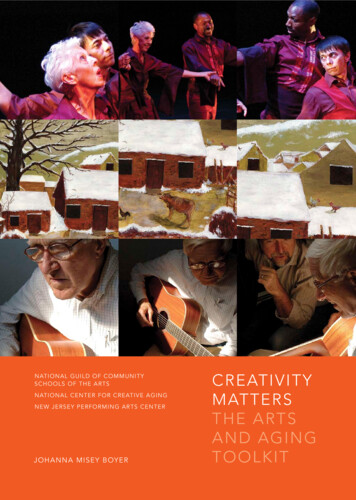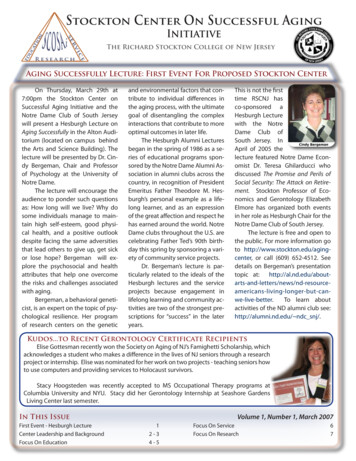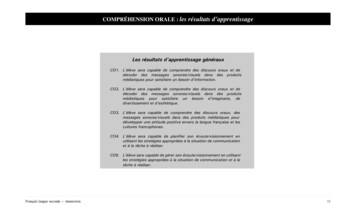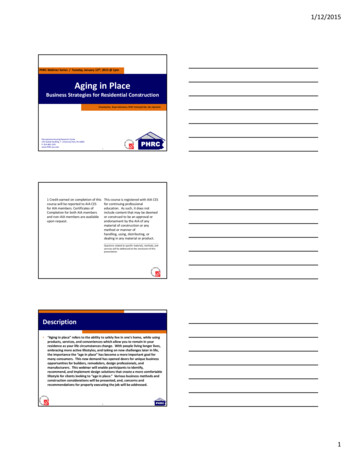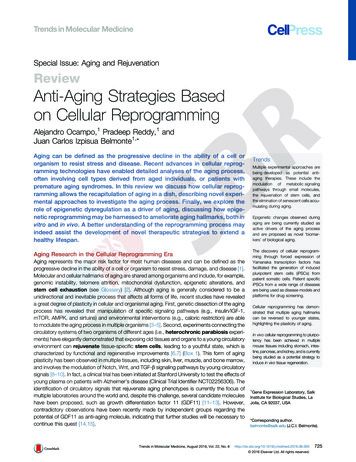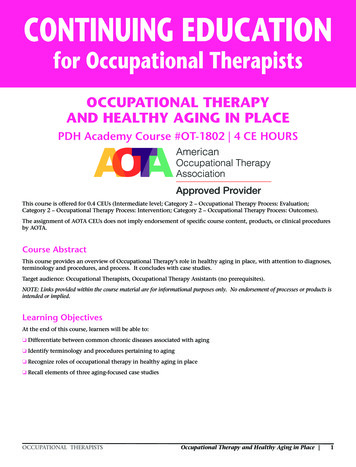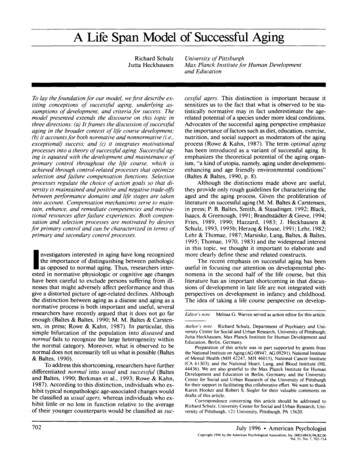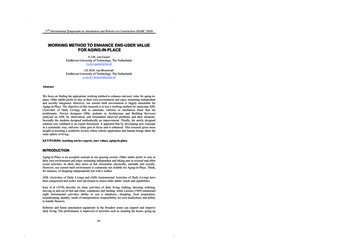
Transcription
27th International Symposium on Automation and Robotics in Construction (ISARC 2010)27th International Symposium on Automation and Robotics in Construction (ISARC 2010)WORKING METHOD TO ENHANCE END-USER VALUEFOR AGING-IN-PLACEWORKING METHOD TO ENHANCE END-USER VALUEFOR AGING-IN-PLACEF.J.M. van GasselEindhoven University of Technology, The Netherlandsf.j.m.v.gassel@tue.nlF.J.M. van GasselEindhoven University of Technology, The Netherlandsf.j.m.v.gassel@tue.nlJ.E.M.H. van BronswijkEindhoven University of Technology, The Netherlandsj.e.m.h.v.bronswijk@tue.nlJ.E.M.H. van BronswijkEindhoven University of Technology, The actWe focus on finding the appropriate working method to enhance end-user value for aging-inplace. Older adults prefer to stay in their own environment and enjoy remaining independentand socially integrated. However, our current built environment is largely unsuitable forAging-in-Place. The objective of this research is to test a working method for analyzing ADL(Activities of Daily Living), and to automate, robotize or mechanize those that areproblematic. Novice designers (MSc students in Architecture and Building Services)analyzed an ADL by observation, and formulated observed problems and their elements.Secondly the students designed methodically an improvement. Thirdly, the newly designedsolution was validated in an expert discussion. It appeared that by developing new conceptsin a systematic way, end-user value gets in focus and is enhanced. This research gives moreinsight in teaching a symbiotic society where robotic application and human beings share thesame sphere of living.We focus on finding the appropriate working method to enhance end-user value for aging-inplace. Older adults prefer to stay in their own environment and enjoy remaining independentand socially integrated. However, our current built environment is largely unsuitable forAging-in-Place. The objective of this research is to test a working method for analyzing ADL(Activities of Daily Living), and to automate, robotize or mechanize those that areproblematic. Novice designers (MSc students in Architecture and Building Services)analyzed an ADL by observation, and formulated observed problems and their elements.Secondly the students designed methodically an improvement. Thirdly, the newly designedsolution was validated in an expert discussion. It appeared that by developing new conceptsin a systematic way, end-user value gets in focus and is enhanced. This research gives moreinsight in teaching a symbiotic society where robotic application and human beings share thesame sphere of living.KEYWORDS: teaching novice experts, user values, aging-in-placeKEYWORDS: teaching novice experts, user values, ce is an accepted concept in our graying society. Older adults prefer to stay intheir own environment and enjoy remaining independent and taking part in societal and othersocial activities. In short, they strive at full citizenship: physically, mentally and socially.However, our current built environment is commonly not suitable for Aging-in-Place. Think,for instance, of shopping independently but with a walker.Aging-in-Place is an accepted concept in our graying society. Older adults prefer to stay intheir own environment and enjoy remaining independent and taking part in societal and othersocial activities. In short, they strive at full citizenship: physically, mentally and socially.However, our current built environment is commonly not suitable for Aging-in-Place. Think,for instance, of shopping independently but with a walker.ADL (Activities of Daily Living) and iADL (instrumental Activities of Daily Living) havebeen categorized and scales were developed to assess older adults’ needs and capabilities.ADL (Activities of Daily Living) and iADL (instrumental Activities of Daily Living) havebeen categorized and scales were developed to assess older adults’ needs and capabilities.Katz et al (1970) describe six basic activities of daily living: bathing, dressing, toileting,moving in and out of bed and chair, continence and feeding, while Lawton (1969) mentionedeight instrumental activities ability to use a telephone, shopping, food preparation,housekeeping, laundry, mode of transportation, responsibility for own medication, and abilityto handle finances.Katz et al (1970) describe six basic activities of daily living: bathing, dressing, toileting,moving in and out of bed and chair, continence and feeding, while Lawton (1969) mentionedeight instrumental activities ability to use a telephone, shopping, food preparation,housekeeping, laundry, mode of transportation, responsibility for own medication, and abilityto handle finances.Robotics and home automation equipment in the broadest sense can support and improvedaily living. The performance is improved of activities such as cleaning the house, going upRobotics and home automation equipment in the broadest sense can support and improvedaily living. The performance is improved of activities such as cleaning the house, going up627627
27th International Symposium on Automation and Robotics in Construction (ISARC 2010)27th International Symposium on Automation and Robotics in Construction (ISARC 2010)and down the stairs, preparing a meal, keeping rooms comfortable and clean, and entertainingpeople. This is especially true when muscle and brainpower decline.and down the stairs, preparing a meal, keeping rooms comfortable and clean, and entertainingpeople. This is especially true when muscle and brainpower decline.In a Dutch study by the Rathenau Instituut (Lau et al, 2009) the researchers “noted that mostresearch efforts and funding seem to be focused on the very high-tech end of the roboticsscale”. A more user-oriented and multi-disciplinary approach is required to enhance thepublic demand.In a Dutch study by the Rathenau Instituut (Lau et al, 2009) the researchers “noted that mostresearch efforts and funding seem to be focused on the very high-tech end of the roboticsscale”. A more user-oriented and multi-disciplinary approach is required to enhance thepublic demand.By an evaluation of 13 projects Franchimon (2009 p17) came to the conclusion that the needsof the users were hardly considered in the application of personal alarm systems, videophonesor burglar alarm systems. He concluded that these applications must be offer by demanddriven needs.By an evaluation of 13 projects Franchimon (2009 p17) came to the conclusion that the needsof the users were hardly considered in the application of personal alarm systems, videophonesor burglar alarm systems. He concluded that these applications must be offer by demanddriven needs.Nowadays new technologies such as robots and home equipment are becoming largelyavailable. In order to use these technologies successfully, it is essential to have a goodunderstanding of the activities of daily living. Using a valid and suitable working method canhelp to get this understanding.Nowadays new technologies such as robots and home equipment are becoming largelyavailable. In order to use these technologies successfully, it is essential to have a goodunderstanding of the activities of daily living. Using a valid and suitable working method canhelp to get this understanding.Van Bronswijk (2009) distinguishes four ages: 1st Age Youth (education), 2nd Age Adulthood(work for income and family formation), 3rd Age Older Adulthood (active retirement) and the4th Age Elderly (frailty). In this study of the working method we focus on the 3rd Age.Van Bronswijk (2009) distinguishes four ages: 1st Age Youth (education), 2nd Age Adulthood(work for income and family formation), 3rd Age Older Adulthood (active retirement) and the4th Age Elderly (frailty). In this study of the working method we focus on the 3rd Age.The aim of this research is to test a working method for analyzing and improving Activitiesof Daily Living (ADL) for older persons in their 3rd Age.The aim of this research is to test a working method for analyzing and improving Activitiesof Daily Living (ADL) for older persons in their 3rd Age.MethodMethodA working method in this study is a set of coherent research activities to get insight andsolutions for problematic ADLs.A working method in this study is a set of coherent research activities to get insight andsolutions for problematic ADLs.The method is subdivided in two different tasks: (i) analyzing and (ii) improving aproblematic ADL element. In spring 2009 three groups of international novice designers(MSc students in Architecture, Building Services and Human Technology Interaction)performed these two tasks as a part of a course in ‘Robotics and Home Automation’ undersupervision of the first author. Before starting the tasks the students were instructed and didsome exercises to become acquainted with the methodology. After the completion of the twotasks the student wrote a personal reflection on his/her learning experiences.The method is subdivided in two different tasks: (i) analyzing and (ii) improving aproblematic ADL element. In spring 2009 three groups of international novice designers(MSc students in Architecture, Building Services and Human Technology Interaction)performed these two tasks as a part of a course in ‘Robotics and Home Automation’ undersupervision of the first author. Before starting the tasks the students were instructed and didsome exercises to become acquainted with the methodology. After the completion of the twotasks the student wrote a personal reflection on his/her learning experiences.Analyzing an ADLAnalyzing an ADLThe instructions for the analysis task were:The instructions for the analysis task were:1. Choose an ADL element, a suitable place to observe it in practice, and ask the subject ifthe group may do the analysis. Choose an activity that has something to do with mobility,and that is influenced by design and nature of the built environment.2. Do a systematic literature search for the chosen ADL element to discover the mostsuitable methodology to describe and assess this activity.1. Choose an ADL element, a suitable place to observe it in practice, and ask the subject ifthe group may do the analysis. Choose an activity that has something to do with mobility,and that is influenced by design and nature of the built environment.2. Do a systematic literature search for the chosen ADL element to discover the mostsuitable methodology to describe and assess this activity.628628
27th International Symposium on Automation and Robotics in Construction (ISARC 2010)27th International Symposium on Automation and Robotics in Construction (ISARC 2010)3. Describe the chosen ADL element after collecting the relevant information withphotographs, videos, interviews, a process description (SADT), etc.4. Analyze the data in a systematic way and draw conclusions. See Table 1 for an exampleof an analysis scheme.5. Prepare your report with the following paragraphs: abstracts, introduction & aim,methodology, results, discussion & conclusions and references.6. Prepare a poster and present and discuss it with fellow students and supervisors.3. Describe the chosen ADL element after collecting the relevant information withphotographs, videos, interviews, a process description (SADT), etc.4. Analyze the data in a systematic way and draw conclusions. See Table 1 for an exampleof an analysis scheme.5. Prepare your report with the following paragraphs: abstracts, introduction & aim,methodology, results, discussion & conclusions and references.6. Prepare a poster and present and discuss it with fellow students and supervisors.Table 1: Example of an analysis schemeTable 1: Example of an analysis t used for theactivity and a descriptionof the sub-activities.Describing the sub-activitiesas completed by humans.1Making the workplacereadyChair: sittingNewspaper: for the potatopeelings Choosing a nice workingplace2Filling pan with waterPan: to store peeledpotatoesTap: water supply Knife: peeling the potato 3Peeling Sub-activityEquipment used for theactivity and a descriptionof the sub-activities.Describing the sub-activitiesas completed by humans.1Making the workplacereadyChair: sittingNewspaper: for the potatopeelings Choosing a nice workingplaceHandling tap and holdingpanControlling the water flown2Filling pan with waterPan: to store peeledpotatoesTap: water supply Handling tap and holdingpanControlling the water flownControlling peeling processPutting the peel on thenewspaper3Knife: peeling the potato EndstagePeeling Controlling peeling processPutting the peel on thenewspaperEndstageImproving a problematic ADLImproving a problematic ADLThe design of an improvement used principles of the morphological approach (Grant, 1984;Cross, 2008) and in particular the morphological matrix. In this matrix the vertical axiscontains a description of functions, and the horizontal axis shows the possible ideas for eachfunction. Each idea is obtained by using creativity techniques. An improvement is a series ofpossible ideas connected by a zigzag line (Figure 1). More lines may be drawn and the bestline is chosen by contrasting them with the requirements.The design of an improvement used principles of the morphological approach (Grant, 1984;Cross, 2008) and in particular the morphological matrix. In this matrix the vertical axiscontains a description of functions, and the horizontal axis shows the possible ideas for eachfunction. Each idea is obtained by using creativity techniques. An improvement is a series ofpossible ideas connected by a zigzag line (Figure 1). More lines may be drawn and the bestline is chosen by contrasting them with the requirements.629629
27th International Symposium on Automation and Robotics in Construction (ISARC 2010)27th International Symposium on Automation and Robotics in Construction (ISARC 2010)Figure 1: Morphological matrix filled with ideas and connected by zigzag lines (Cross, 2008).Figure 1: Morphological matrix filled with ideas and connected by zigzag lines (Cross, 2008).The instructions for the improving tasks were follows:The instructions for the improving tasks were follows:1.2.3.4.5.6.7.Choose an aim to improve the problematic ADL element chosen by your group.Describe and/or sketch the initial situation and the end situation of the ADL element.Formulate characteristics of the initial and the end stage of the ADL element.Formulate the requirements of improvement.Draw a morphological matrix with sub-activities of a new ADL.Create ideas for the sub-activities with the help of creativity techniques.Draw in the scheme 2 or 3 zigzag lines which indicate a combination of ideas for the subactivities. The zigzag lines represent then the solutions.8. Choose the best solution by contrasting them with the requirements.9. Develop the best solution.10. Write a group reflection about the solution.11. Write a report with the following paragraphs: aim of the improvement, program ofrequirements, morphologic scheme and choice of best solution.12. Prepare a PowerPoint presentation to evaluate the results with the other students andsupervisors.1.2.3.4.5.6.7.ResultsResultsThe groups wrote a report for each task. In addition the results of the problem analyses andimprovement were presented and discussed with the colleague students, the supervisor andexperts. The results of the analyses are summarized in Table 2 and of the improvement inTable 3.The groups wrote a report for each task. In addition the results of the problem analyses andimprovement were presented and discussed with the colleague students, the supervisor andexperts. The results of the analyses are summarized in Table 2 and of the improvement inTable 3.630630Choose an aim to improve the problematic ADL element chosen by your group.Describe and/or sketch the initial situation and the end situation of the ADL element.Formulate characteristics of the initial and the end stage of the ADL element.Formulate the requirements of improvement.Draw a morphological matrix with sub-activities of a new ADL.Create ideas for the sub-activities with the help of creativity techniques.Draw in the scheme 2 or 3 zigzag lines which indicate a combination of ideas for the subactivities. The zigzag lines represent then the solutions.8. Choose the best solution by contrasting them with the requirements.9. Develop the best solution.10. Write a group reflection about the solution.11. Write a report with the following paragraphs: aim of the improvement, program ofrequirements, morphologic scheme and choice of best solution.12. Prepare a PowerPoint presentation to evaluate the results with the other students andsupervisors.
27th International Symposium on Automation and Robotics in Construction (ISARC 2010)27th International Symposium on Automation and Robotics in Construction (ISARC 2010)Table 2. Analysis resultsTable 2. Analysis resultsStudent groupAStudent groupBCABCADL chosenUsing buses and trainsDish washingPreparing foodADL chosenUsing buses and trainsDish washingPreparing foodSituationchosenRailway station inEindhovenPrivate apartmentPrivate apartment andassisted living facilitySituationchosenRailway station inEindhovenPrivate apartmentPrivate apartment andassisted living facilityResearchobjectsTwelve older persons,users of the publictransportTwo older persons(aged 77 and 79 years) ResearchobjectsTwelve older persons,users of the publictransportTwo older persons(aged 77 and 79 years) Problemanalyzingresults Hard to get into thetrain with luggageRude fellowpassengersRude bus driversThe lift to the trainplatform can only beused with the help ofstation staff Bending to storethings in the lowercabinetStretching to storeluggage uppercupboardGrasping, causedby tremorHeight of the sink Older woman livingaloneOlder womantemporarily living inan assisted livingfacilityMashing potatoesOpening packagingPouring potatoes offTransfer a number offood products in onecontainerProblemanalyzingresults Hard to get into thetrain with luggageRude fellowpassengersRude bus driversThe lift to the trainplatform can only beused with the help ofstation staff Bending to storethings in the lowercabinetStretching to storeluggage uppercupboardGrasping, causedby tremorHeight of the sink Older woman livingaloneOlder womantemporarily living inan assisted livingfacilityMashing potatoesOpening packagingPouring potatoes offTransfer a number offood products in onecontainerDiscussionDiscussionAll tasks have been completed by the groups and have resulted in an improvement of threeproblematic ADLs. The solutions were developed on a conceptual level, and have not beenengineered nor checked in practice. Some improvements became known but not used in thesituation of the tests.All tasks have been completed by the groups and have resulted in an improvement of threeproblematic ADLs. The solutions were developed on a conceptual level, and have not beenengineered nor checked in practice. Some improvements became known but not used in thesituation of the tests.Spending more time on the tasks and getting more experience with the working method willenhance the quality of the ADL improvement.Spending more time on the tasks and getting more experience with the working method willenhance the quality of the ADL improvement.Feedback by future users will also improve the quality of the ADL supports (Lau andFranchimon 2009).Feedback by future users will also improve the quality of the ADL supports (Lau andFranchimon 2009).In the personal reflections on using the working method the students stated the followingstatements:In the personal reflections on using the working method the students stated the followingstatements: “Very useful and broadly applicable”;“To do observations make you real aware of the problem”;“Some solutions already existed but not for this specific ADL”;“The following steps in the method got our special attention: research, ideas, engineeringand test; some steps are repeated”;“Take time to formulate the problem and the solution”;“You worked with more than one solution”.631 “Very useful and broadly applicable”;“To do observations make you real aware of the problem”;“Some solutions already existed but not for this specific ADL”;“The following steps in the method got our special attention: research, ideas, engineeringand test; some steps are repeated”;“Take time to formulate the problem and the solution”;“You worked with more than one solution”.631
27th International Symposium on Automation and Robotics in Construction (ISARC 2010)27th International Symposium on Automation and Robotics in Construction (ISARC 2010)Table 3: Results improvementTable 3: Results improvementStudent groupAADL chosenEntering a train withluggageRequirementsdescriptionBDish washing ImprovementresultsA retractable rampStudent group Wash dishes easilyRobust functionEasy to learn to useEasy to rememberhow to useOther person canuse it tooMovable sinkFaucet for soapButton for waterRubber glovesMoving beltElectric brush anddryerAdjustable cupboardCMashing potatoesADL chosenThe muscle strengththat is needed to usethe equipment mustbe lower than 310Newton The weight of theequipment ismaximal 750 gNew kitchen tool‘Preasher’ is used topress vegetables andfruits into tiny pieces.The solution lies in thelever system, amplify thepressing power of theuser.Requirementsdescription Sketch ofchosenimprovementReflection onimprovementAEntering a train withluggageBDish washing ImprovementresultsA retractable ramp Wash dishes easilyRobust functionEasy to learn to useEasy to rememberhow to useOther person canuse it tooMovable sinkFaucet for soapButton for waterRubber glovesMoving beltElectric brush anddryerAdjustable cupboardCMashing potatoesThe muscle strengththat is needed to usethe equipment mustbe lower than 310Newton The weight of theequipment ismaximal 750 gNew kitchen tool‘Preasher’ is used topress vegetables andfruits into tiny pieces.The solution lies in thelever system, amplify thepressing power of theuser. Sketch ofchosenimprovementThe ramp is useful butneeds furtherdevelopment.These products existalready, acceptance canbe enhanced them byusing them at an earlierstage to use them in anearlier stage.Take enough time toobserve the ADLelement of the person;do experiments with thechosen solutions.Reflection onimprovementThe ramp is useful butneeds furtherdevelopment.These products existalready, acceptance canbe enhanced them byusing them at an earlierstage to use them in anearlier stage.Take enough time toobserve the ADLelement of the person;do experiments with thechosen solutions.It is important for developers of new solutions to support problematic ADL to includespecific competences in user-based design.It is important for developers of new solutions to support problematic ADL to includespecific competences in user-based design.The aim of this research has been to test a working method for analyzing an element of anADL, and to automate, robotize or mechanize it. Some elements of this working methodappear to be essential for successfully improving the execution of problematic ADLs. Animportant addition will be producing prototypes en testing these with users.The aim of this research has been to test a working method for analyzing an element of anADL, and to automate, robotize or mechanize it. Some elements of this working methodappear to be essential for successfully improving the execution of problematic ADLs. Animportant addition will be producing prototypes en testing these with users.632632
27th International Symposium on Automation and Robotics in Construction (ISARC 2010)27th International Symposium on Automation and Robotics in Construction (ISARC 2010)ConclusionsConclusionsOur working method will decrease the gap between technology push and users pull.Our working method will decrease the gap between technology push and users pull.The new information has already been successful in the world of user-oriented design, but ishardly used in the domain of built environments, particular in the domain of Aging-in-Place.The new information has already been successful in the world of user-oriented design, but ishardly used in the domain of built environments, particular in the domain of Aging-in-Place.AcknowledgementsAcknowledgementsThe authors thank the Architecture, Building Services and Human Technology Interactionstudents for their cooperation.The authors thank the Architecture, Building Services and Human Technology Interactionstudents for their cooperation.ReferencesReferencesADL http://en.wikipedia.org/wiki/Activities of daily living Observed 11th March 2010.ADL http://en.wikipedia.org/wiki/Activities of daily living Observed 11th March 2010.Bronswijk, JEMH van, 2009. Basics of Gerontechnology. Presentation at the InternationalConference on Gerontic Technology and Service Management. Nankai Institute ofTechnology, Tsaotun, Nantou, Taiwan.Bronswijk, JEMH van, 2009. Basics of Gerontechnology. Presentation at the InternationalConference on Gerontic Technology and Service Management. Nankai Institute ofTechnology, Tsaotun, Nantou, Taiwan.Cross, N, 2008. Engineering Design Methods. John Wiley & Sons Ltd.Cross, N, 2008. Engineering Design Methods. John Wiley & Sons Ltd.Franchimon, F, 2009. Gezonde gebouwinstallaties voor de 21ste eeuw. Eindhoven Universityof Technology.Franchimon, F, 2009. Gezonde gebouwinstallaties voor de 21ste eeuw. Eindhoven Universityof Technology.Grant, DP 1984. Creative idea production in architecture: the morphological approach. SanLuis Obispo, California: The Design Methods Group.Grant, DP 1984. Creative idea production in architecture: the morphological approach. SanLuis Obispo, California: The Design Methods Group.Katz, S, TD Downs, HR Cash and RC Grotz,1970. Progress in Development of the Index ofADL. The Gerontologist10 (1 part 1): pp 20-30.Katz, S, TD Downs, HR Cash and RC Grotz,1970. Progress in Development of the Index ofADL. The Gerontologist10 (1 part 1): pp 20-30.Lau, YY, C van‘t Hof and R van Est, 2009. Beyond the Surface. An Exploration inHealthcare Robotics in Japan. The Netherlands, The Hague, Rathenau Instituut TA Report.Lau, YY, C van‘t Hof and R van Est, 2009. Beyond the Surface. An Exploration inHealthcare Robotics in Japan. The Netherlands, The Hague, Rathenau Instituut TA Report.Lawton, MP and EM Brody, 1969. Assessment of older people: Self-maintaining andinstrumental activities of daily living. The Gerontologist 9: pp 179-186.Lawton, MP and EM Brody, 1969. Assessment of older people: Self-maintaining andinstrumental activities of daily living. The Gerontologist 9: pp 179-186.633633
Bronswijk, JEMH van, 2009. Basics of Gerontechnology. Presentation at the International Conference on Gerontic Technology and Service Management. Nankai Institute of Technology, Tsaotun, Nantou, Taiwan. Cross, N, 2008. Engineering Design Methods. John Wiley & Sons Ltd. Franchimon, F, 2009. Gezonde gebouwinstallaties voor de 21ste eeuw.


